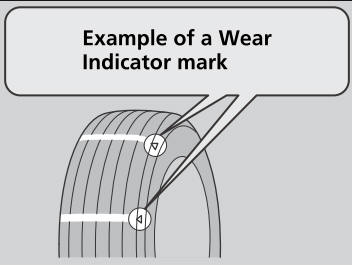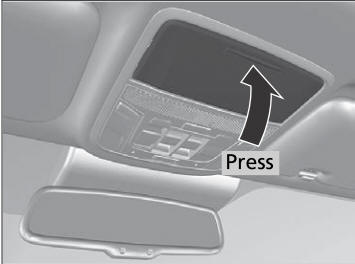Honda CR-V: Checking and Maintaining Tires / Wear Indicators
Honda CR-V 2017-2025 Owner's Manual / Maintenance / Checking and Maintaining Tires / Wear Indicators
The groove where the wear indicator is located is 1/16 inch (1.6 mm) shallower than elsewhere on the tire. If the tread has worn so that the indicator is exposed, replace the tire.
Worn out tires have poor traction on wet roads.

 DOT Tire Quality Grading (U.S. Vehicles)
DOT Tire Quality Grading (U.S. Vehicles)
The tires on your vehicle meet all U.S. Federal Safety
Requirements. All tires are also graded for treadwear, traction,
and temperature performance according to Department of
Transportation (DOT) standards...
 Tire Service Life
Tire Service Life
The life of your tires is dependent on many factors, including driving habits,
road
conditions, vehicle loading, inflation pressure, maintenance history, speed, and
environmental conditions (even when the tires are not in use)...
Other information:
Honda CR-V 2017-2025 Owner's Manual: Brake Fluid
Specified fluid: Honda Heavy Duty Brake Fluid DOT 3 Checking the Brake Fluid The fluid level should be between the MIN and MAX marks on the side of the reserve tank. NOTICE Brake fluid marked DOT 5 is not compatible with your vehicle's braking system and can cause extensive damage...
Honda CR-V 2017-2025 Owner's Manual: Using the Remote Transmitter
Press the power tailgate button for more than one second to operate when the power mode is in VEHICLE OFF (LOCK). Some exterior lights flash and the beeper sounds. If you press the button again while the power tailgate is moving, it will stop...
Categories
- Manuals Home
- Honda CR-V Owners Manual
- Honda CR-V Service Manual
- Odometer and Trip Meter
- Rear Seats
- Multi-View Rear Camera
- New on site
- Most important about car
Sunglasses Holder
To open the sunglasses holder, press and release the indent. To close, press it again until it latches.
You can store eyeglasses and other small items in this holder.

Copyright © 2025 www.hocrv.com
